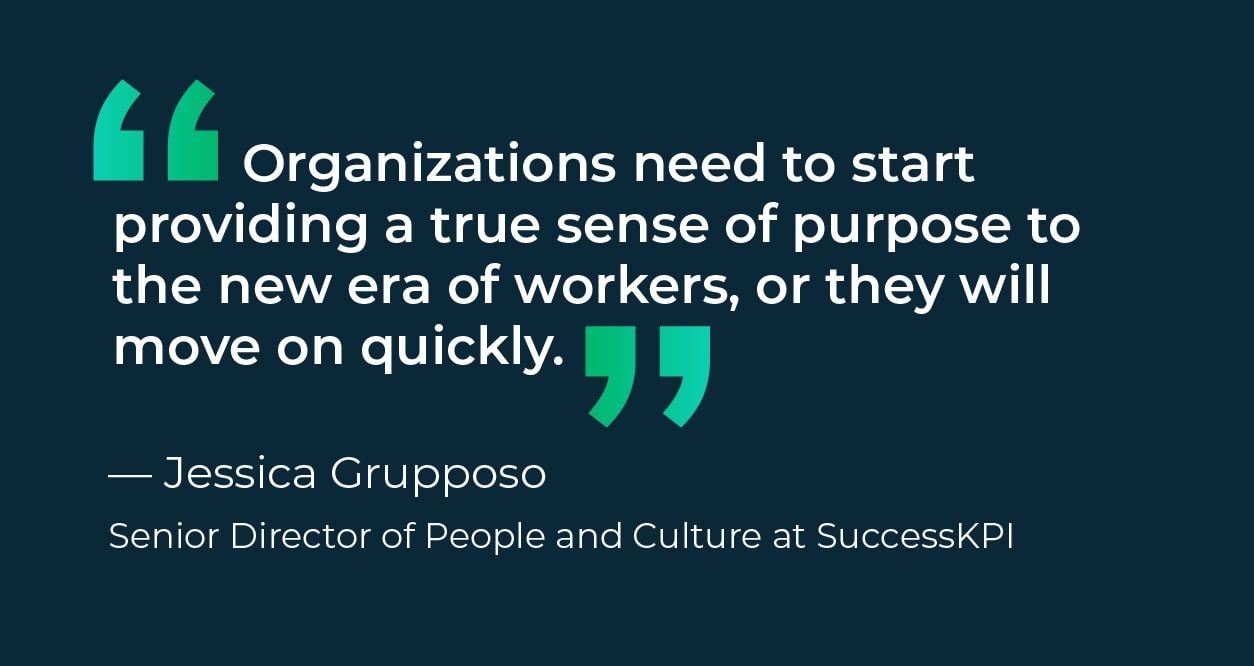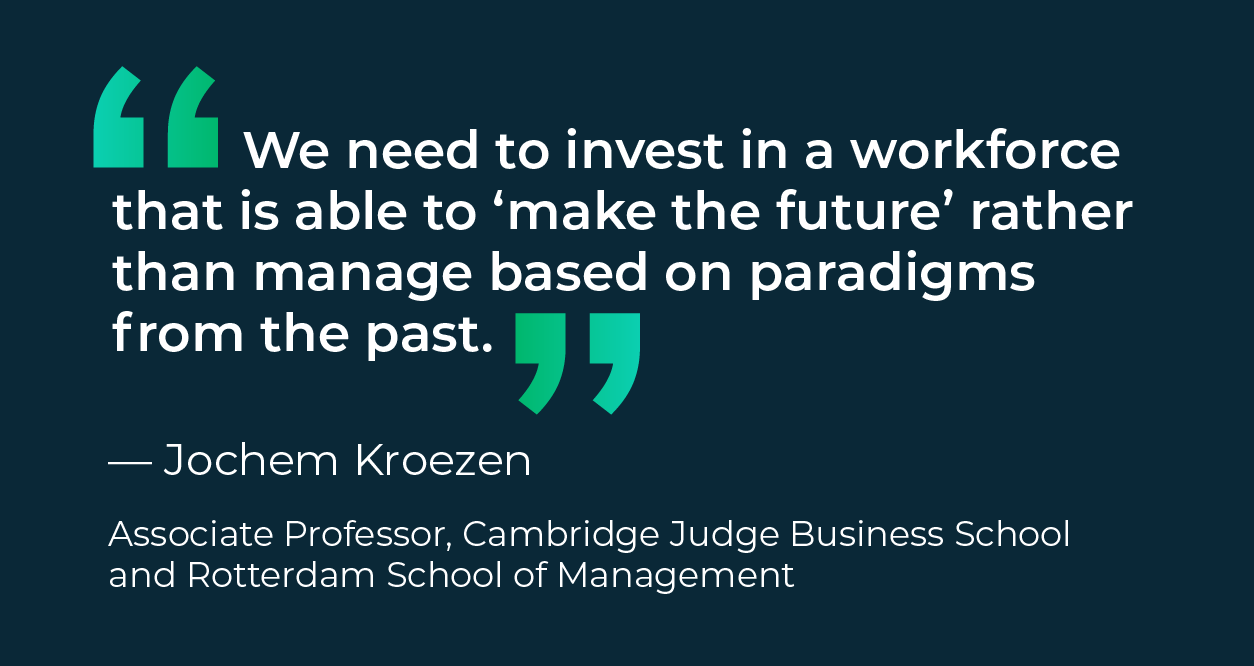Experts Share Key Workforce Management and Leadership Trends in 2023

At the outset of 2023, one thing has become clear to organizational leaders: the only constant is change.
While the disruptions caused by COVID-19 have slowed, new challenges stemming from inflation, supply chain issues, and a potential recession on the horizon will play a major role this year.
We recently spoke with five leaders in organizational development and HR to hone in on the leadership and workforce management trends that will drive corporations in 2023. Their expert opinions offer essential insights into the challenges—and opportunities—of the year to come.
Major Workforce Management Challenges in 2023
With a potential recession paired with a tight labor market, “Organizations and leaders will continue to face uncertainty in 2023, mainly driven by the many political and socioeconomic global conflicts that continue to arise,” says Jessica Grupposo, a university professor and Senior Director of People and Culture at SuccessKPI.
So, what are the salient challenges to expect in 2023?
1. Creating Opportunities for Purposeful Work
More than ever, employees expect their work to offer not just financial rewards but also a sense of purpose. A recent McKinsey & Company survey found 70% of U.S. employees say their sense of purpose is defined by their work—and that the pandemic prompted many employees to reconsider whether their roles feel meaningful.
“Organizations need to start providing a true sense of purpose to the new era of workers, or they will move on quickly,” says Grupposo, noting that corporate commitments to environmental, social, and governance (ESG) issues are more important than ever in both hiring and employee retention.
Jochem Kroezen, Associate Professor for the Cambridge Judge Business School and the Rotterdam School of Management at Erasmus University (Netherlands), agreed, naming “empowering the workforce to deal with societal challenges like climate change, inequality, and social division” as a priority for 2023.
2. Prioritizing Human Values
In addition to deriving purpose from work, today’s employees increasingly expect their workplaces to provide a sense of community and social support.
“As humans, [employees] have all kinds of needs that extend well beyond the office,” says Suzy Walther, Chief People Officer at FalconX and a guest speaker for Wharton Executive Education. “They’ll be seeking organizations that understand on a personal and individual level what it takes for them to do their life’s best work, which might look different than the needs of the individual next to them.”
Grupposo says leading in 2023 will require:
- A deeper focus and understanding of diversity, equity, and inclusion
- Strong benefits and mental health support
- Providing psychological safety in the workplace
- Increased empowerment
3. Doing More with Less
The likely recessionary environment of 2023 is expected to shrink budgets at many organizations, even as the job market remains tight. This poses new challenges for retaining and engaging employees.
With fewer resources at their disposal, Walther says, it’s important for leaders to prioritize the work that is most critical to the organization’s future, and to reallocate their best-performing employees toward those tasks.
D Mark Schumann, an executive coach and instructor at the Wharton School of Business and New York University, also emphasizes the importance of employee engagement. “We need to redefine what engagement means and rethink how culture can inspire people to connect no matter where they may work. And that will require us, as leaders, to look beyond the change we manage to make the most of the opportunities we can maximize.”
Priorities and Strategies for Upskilling and Reskilling
As companies struggle to address persistent skills gaps in a tight labor market, employee upskilling and reskilling have become more important than ever.
“Assessing the skills needed in your organization to do the most impactful jobs and offering existing employees access to mentors, cross-functional on-the-job training, digital, in-person training, and other means of skill development will be crucial to driving success,” Grupposo says.
According to our experts, focusing on skills development can have an outsized impact in several areas, including the following.
1. Leadership Training
Good leaders are invaluable in engaging and recruiting employees, while bad ones are a true liability to their organizations.
Explosive growth in many organizations over the past few years has meant many new managers did not receive the support they needed during the transition. Peer groups and coaching and mentoring programs can help create a scaffolding of support to assist these managers as they grow.
“Yesterday’s leaders are not always capable of addressing today’s growing demands and needs,” Grupposo says. In particular, leaders need to develop a better understanding of the human side of work including:
- The critical role of DEI
- Social responsibility
- Psychological safety
- Intrinsic motivation
- Empathy
- Emotional intelligence
2. Soft Skills Development
While technical skills are critical, in most roles, so-called “soft skills” like communication, teamwork, and adapability are equally important—especially as employees adjust to new realities and ways of working.
“For me, the most concerning skill gap is not about a specific discipline,” Kroezen says, “but about our general neglect of the importance of tacit and embodied skills that are uniquely human. We need to invest in a workforce that is able to ‘make the future’ rather than manage based on paradigms from the past.”
As executive leadership coach Alessandra Bortolussi—also a success coach at Wharton Executive Education and Cambridge Judge Business School—explains, necessary soft skills include both relational skills (like coaching, leadership, and emotional intelligence) and objective-related skills such as decision-making, goal-setting, and systemic thinking.
3. Strategic Technology Use
New technologies are essential to business growth, and upskilling and reskilling to build tech skills in-house is much often more cost-effective than hiring externally. Opportunities like the Emeritus Tech Academy can help leaders build out key capabilities within their existing talent pool.
However, the end goal of developing technical skills should not stop with the technology itself. Instead, companies should think strategically about how technology can free up employees to focus on high-level tasks.
“If you aren’t maximizing ML/AI and other forms of tech to drive what can be automated so that you can focus on allowing your employees to contribute in more meaningful ways, you are missing the point,” Grupposo says.
Strategies for Addressing the Talent Shortage
The talent shortage that has strained organizations for the past several years is expected to continue in 2023, with highly-skilled employees in particularly short supply. Our experts offered strategies for recruiting, retaining, and upskilling employees to meet corporate demand.
1. Provide Opportunities for Advancement
Since a lack of advancement opportunities often drives turnover, investing in employee development and career pathing opportunities is a powerful driver of engagement and retention.
“Places where the labor market is particularly tight are also often places where we have created lower quality jobs and have reduced work autonomy and job complexity,” Kroezen says. “In an age where people are increasingly in control over their life paths and care about more than having a solid income, meaningful work becomes more important.”
In light of that fact, employers should focus on offering employees a clear path forward within the organization, complete with opportunities to gain necessary skills. Doing so demonstrates their commitment to the employee long-term.
2. Proactively Source Internal Talent
While many companies talk about their internal talent development programs, Walther says, few have robust internal recruitment pipelines. Investing time and resources in building out that functionality can pay long-term dividends.
ALSO READ: Hire New Talent or Reskill Internally? How to Decide
“To maximize internal recruiting,” Grupposo says, “you need to know what skills your company already has in-house. Leaders can start by building out a database of employees and their skills (either reported by managers or self-reported). When new roles open, recruiters can start with that database to find internal talent before posting the position broadly.”
Grupposo adds, “Sometimes, non-traditional candidates from other areas of the organization are an excellent choice, provided that they have demonstrated an interest in and aptitude for learning.”
3. Prioritize Recognition and Retention
In addition to offering advancement opportunities to existing employees, companies need to create a comprehensive approach to employee retention. One way to motivate employees is by recognizing their achievements.
“Managers tend to take talent for granted and focus on the individuals who are causing issues and underperforming,” Bortolussi says. “In a team environment, though, seeing a manager focus their attention elsewhere most of the time can cause demotivation and uncertainty.”
Emerging Workforce Trends to Watch
The experts we surveyed also shared emerging trends to keep an eye on in 2023.
1. Human-Centricity
As Kroezen noted, many people assume that the future of work will be increasingly automated and tech-driven. “Yet, the uniquely human touch that people can bring to critical work processes will become more, not less, important in a world where we can theoretically automate everything,” Kroezen says. “The leading organizations of the future will be human-centric organizations that put people before technology.”
2. Skills-Based Hiring and Development
Traditionally, most companies have hired based on job descriptions rather than specific skills. In the near future, Walther predicts, companies will instead focus on skills and aptitudes when hiring, whether internally or externally. “The more you understand the skills required to do a job and the skills your people have (and don’t have),” Walther says, “the more strategic you can be in hiring for those skills and developing your current workforce toward them.”
3. Shifting Approaches to Salary and Benefits
Since the pandemic, the way we work has changed significantly, and so have employee expectations. Increasingly, the desire for flexibility and balance is front-of-mind.
In response to these changing employee expectations, Grupposo says, some companies are now revisiting their benefits models. Instead of offering a set list of benefits, they instead provide a stipend to employees and allow them to pick from a menu of offerings to best meet their needs.
Similarly, salary is no longer the be-all, end-all in hiring. “Salary trends are shifting and are no longer the reason we are choosing jobs,” Grupposo says. “People are taking cuts in pay for the right environment, benefits, and support, especially work-life balance.”
Workforce Management for Today and Beyond
Companies need to remain nimble in their approach to workforce development in today’s world. A robust, comprehensive approach to employee development will help organizations meet—and rise above—the challenges to come.
Learn more about partnering with Emeritus Enterprise to develop online employee training programs as part of your workforce management plan in 2023.





